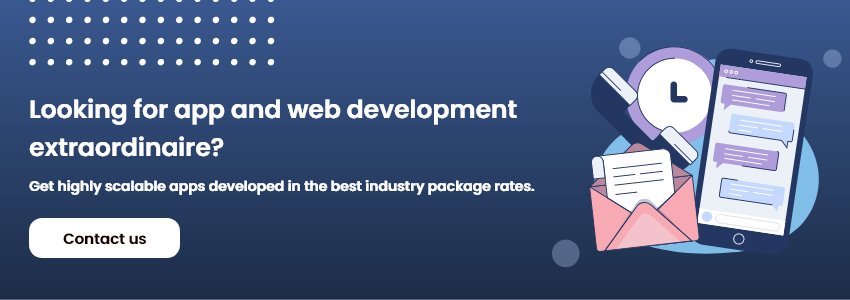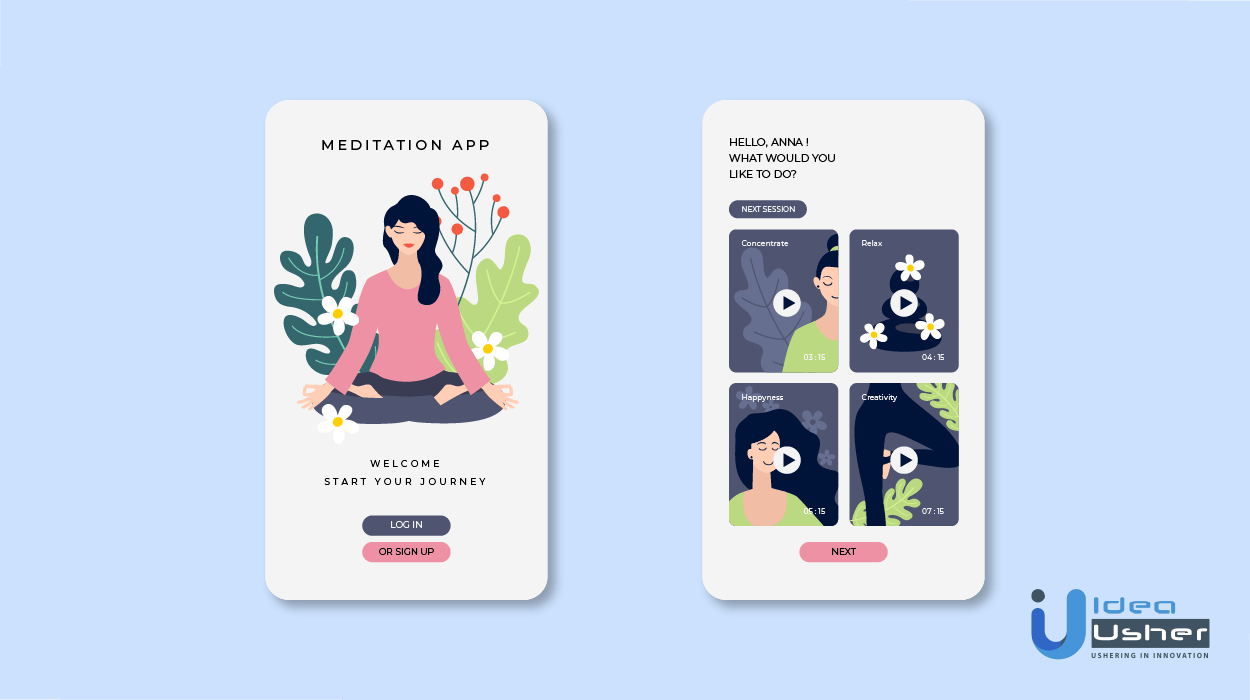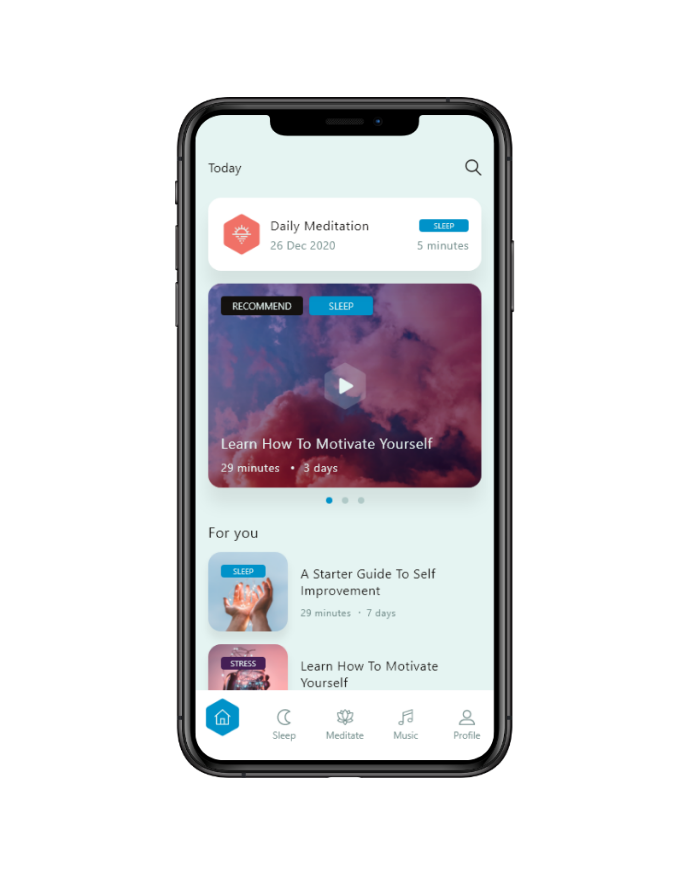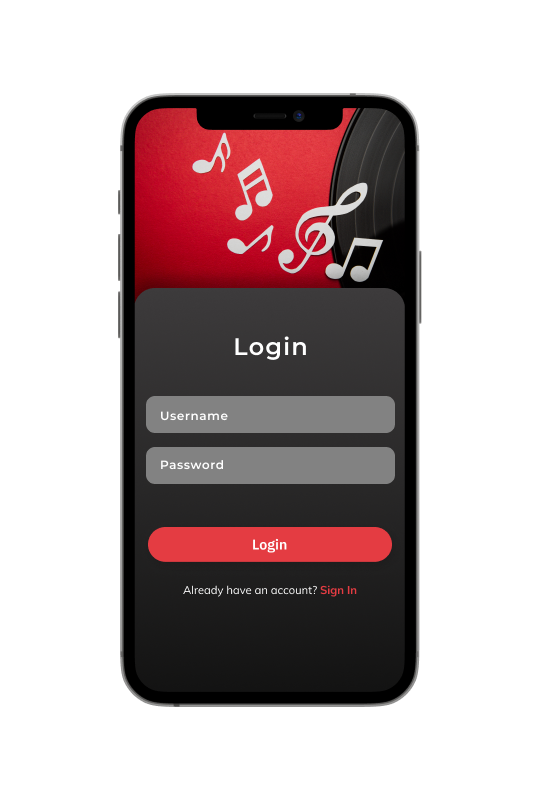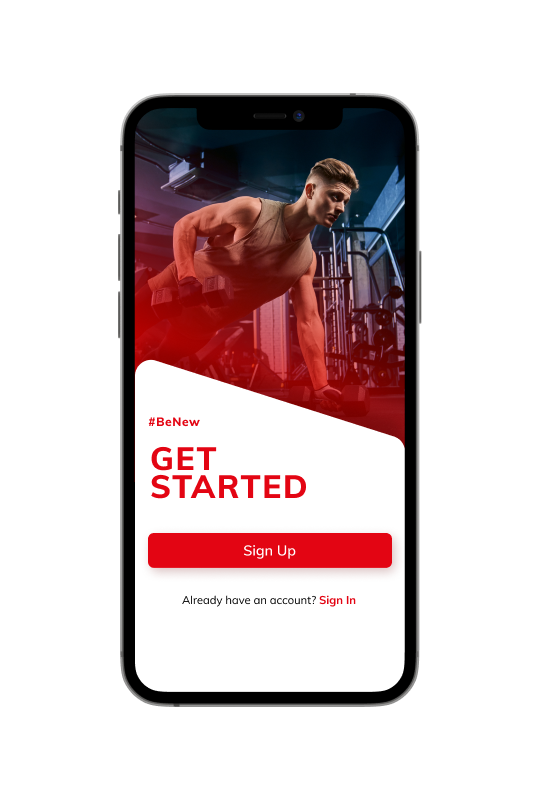Today, through this article, we will discuss “how to create a meditation app?” and learn about the app’s need and relevance in our daily lives.
According to Statista, In December 2022, meditation app Calm was the highest-grossing health-related app worldwide, with in-app revenues of almost 6.4 million U.S. dollars in the examined period. Headspace ranked second, with approximately five million U.S. dollars in revenues.
There is a range of applications available for the user to discover. From losing weight in 60 days to reminding you to drink water from time to time. We have an app for every work possible. And we see no slowing down of this graph, not anytime soon.
If you look around for a second, you will see, from kids to adults, from workaholics to fitness enthusiasts; everyone uses their phone. Their minds evaluate the number of steps they have to take to finish their daily goal or the number of work reminders their screens display.
Each app tells a story.
This is how technology has taken over our daily lives and routines.
We know that we spend about 88% of our time on the apps we use. We use our smartphones while we walk, talk, cook or even sleep.
The significance of mobile apps in our daily lives:
The ongoing transformation of mobile phones isn’t just limited to calling and receiving text messages; it’s way more than that. We cannot neglect the fact, how these smartphones and smartwatches have revolutionized our lives for good.
Furthermore, It has become the colossal point of attention for users and businesses altogether, courtesy of the variety of features and opportunities these smartphones offer.
The unlimited opportunities the technology provides are undeniably unstoppable.
Who would’ve thought booking a movie ticket without being physically present would be so easy? or learning how to practice meditation without rolling out your yoga mats will be satisfying?
Our lives have been a bit more accessible with such applications laid in front of us. At this moment, we can see the use of mobile applications in all possible sectors, like
- corporate offices handling work from home
- Education sectors, sharing notes and classes over various platforms
- Social media
- Cooking classes
- Shopping
- Monitoring stocks and shares
Regularly users seek updated versions of these apps.
Hence, app developers and app developing companies continue working on keeping the app up to date.
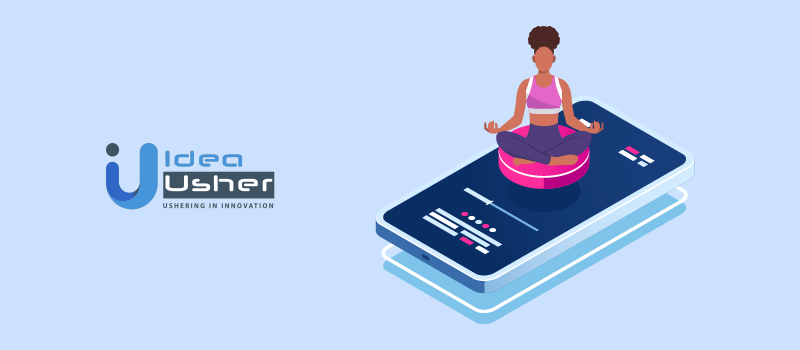
Following the increase in demand, there has been a substantial increase in new app developers and app development
How do these mobile apps make money?
The standing of an app is determined by the number of downloads it has received.
Even though your idea behind the app is exclusive and seems relevant, it will not sail if it fails to receive the minimum required downloads.
Here, knowing the audience and the right promotional strategy is the stepping stone to make an app run successfully. The idea of creating apps needs proper guidance and research to back the application up.
If you are making a beginner’s meditation app, you need to go through a detailed evaluation.
What are the prerequisites I need to fulfill? How to earn through these free download apps?
To generate an income through the free apps you create, here are three major monetization strategies to guide you:
1. Advertising:
Effective promotion of your app, which should reach the audience you are targeting, boost the number of downloads and user’s interest simultaneously.
The app owner receives remuneration according to the number of clicks on the ad or when the user completes the installation via the advertisement.
2. Subscriptions:
We can count subscriptions as one of the most crucial strategies so far. The app owners can provide a free app trial period to develop the user’s interest. They later charge the users who want to continue the subscription.
3. In-App purchases:
In-app purchases are the ones that are made from the apps directly. These purchases help access the advanced and powerful features and make the users’ interaction much more accessible and empowered. In simple words, it will help app owners sell their virtual items quickly.
Meditation Apps: The need for mindfulness apps in 2023
As we are on mobile apps and the increased likelihood of innovative and life-related applications, let’s talk about the growing hype around the meditation app market.
- According to Google, the number of searches around yoga and meditation apps, like ‘meditation for beginners app,’ ‘mindfulness apps’ and ‘guided meditation’ have also increased by 65%.
- The surge is quite evident as more than 52 million users downloaded the top 10 meditation apps in 2019 and 2020.
- As users are getting acquainted with mental health aspects, the need for apps revolving around this idea became more prominent.
The arrival of coronavirus and its effect urged people to look back upon how they have been leading their lives upto this point. Mainly, the fact that anxiety and stress is no longer an unfamiliar term brings a significant discussion to the table.
“How do we battle stress and anxiety organically?”
We all have brushed this topic under the carpet, intending to never deal with it again, but the case never left. Not only did it hindered our work routine, but it also made us a comfortable place in our day-to-day chores.
Cases like insomnia, eating disorders, anxiety-ridden work routines became a casual cause. And so we made peace with the fact that this is life.
How did lockdown change us?
Not only did it urge us to stay at home, but it also gave us plenty of time to reflect upon ourselves and determine the problems within us.
People started finding new ways to deal with their rising issues, most of them found shelter under these meditation apps.
The need for yoga and healthy exercises took a drastic turn, and the population became acquainted with the concept of a healthy lifestyle and how vital maintaining mindfulness was in life.
An era of spiritual living finally came across a new horizon.
How well do these meditation apps work?
During the year 2019, the search for “meditation apps for beginners,” “ mindfulness apps for cancer patients,” “top 10 best meditation apps,” “how to create a meditation app?” “cost of a mediation app” could be seen all over the internet.
People wanted to know the benefits of meditation and what changes it could bring in their daily lives.
Meditation apps like calm, headspace, and ‘the mindfulness daily’ became popular with each passing week.
Headspace even went to earn $100 million in revenue in 2019 and is expected to generate around $100-$150 gain for 2020.
In the beginning, headspace led the way; however, Calm garnered a wave of new followers from its iOS award for App of the Year in 2017.
These apps promote the idea of mindfulness and the need for meditation in our lives.
They focus primarily on the problems experienced by the users and prepare routines accordingly. Their offers range from breathing exercises, guided meditations, silent or voice routines to stress relief, lessen anxiety disorder through relaxed music and diet order.
The means of these apps becoming a success were always dependent on the quality of services they offered. From meditation for beginners to silent meditation for the experienced ones or even routines to show support were made available to the users under different packages.

Through headspace, simply being, we try to train our brain to focus at the moment and streamline our thoughts and ideas.
We try to foster more kindness and be more environmentally strong enough to make informed and calculated decisions.
Must of Features of Meditation App
1. Profile Creation
If you’re planning to develop a meditation app, there’s one essential feature you can’t overlook: profile creation. This feature allows your users to create their own unique profiles within your app, giving them a personal space to store and access information related to themselves and their activities.
By providing users with a profile, you give them a sense of ownership and agency over their experience with your app. They can tailor the content they see, track their progress over time, and even connect with other users.
To put it simply, profile creation is the backbone of any social or community-based app. It’s what allows users to engage with one another and feel a sense of belonging. So, if you’re serious about creating an app that fosters relaxation and well-being, make sure to prioritize this feature from the start.
2. Introductory Courses & Programs
Another crucial component of a meditation app is onboarding tutorials for beginners. These tutorials will guide new users through the basics of meditation and related exercises, providing step-by-step instructions on how to use the app effectively.
Since these tutorials are often the first point of contact between users and your app, it’s important that they’re visually engaging and easy to follow. By presenting information in a clear, concise way, you can help users get up to speed quickly and start enjoying the benefits of your app right away.
As with any feature of your app, it’s important to keep the user experience in mind when creating onboarding tutorials. By making them accessible and user-friendly, you’ll ensure that users have a positive first impression of your app and are more likely to continue using it in the long term. So, make sure to invest the time and effort necessary to create high-quality tutorials that will set your users up for success.
3. Complete Courses & Masterclass
One of the standout features of a meditation app is the Masterclasses feature, which gives users access to exclusive classes taught by some of the world’s leading mindfulness experts.
These classes provide users with a unique opportunity to learn from the best in the business and deepen their understanding of mindfulness and related practices. By featuring classes from a diverse array of experts across the globe, you can offer users a truly global perspective on these important topics.
Incorporating Masterclasses into your app can also help distinguish it from other mindfulness apps on the market. By providing access to high-quality content that users can’t find anywhere else, you’ll give them a compelling reason to choose your app over the competition.
Ultimately, the Masterclasses feature is all about providing users with an exceptional experience that will keep them engaged and motivated to continue using your app. By investing in this feature, you’ll show users that you’re serious about helping them achieve their goals and live a more mindful life.
4. Personal Statistics
Another important feature to include in your meditation app is the ability for users to track their progress in meditation on a day-to-day basis. If you integrate with wearables such as smartwatches and fitness trackers, you can even display stats that show how a user’s quality of sleep is improving over time.
Visual representation is key when it comes to personal statistics. Consider using graphs, charts, and animations to make it easy for users to see how they’re progressing over time. By making progress tracking fun and interactive, you’ll keep users engaged and motivated to continue using your app.
Additionally, by showing users how their meditation practice is benefiting their sleep quality, you’ll provide them with even more incentive to continue using your app regularly. This can help build brand loyalty and encourage users to recommend your app to their friends and family.
5. Reminders
These reminders can take many forms, including reminders to practice mindfulness, to get enough sleep, and to check in with the app regularly.
By sending regular reminders to users, you can help them develop positive habits and stay on track with their mindfulness practice. These reminders should be tailored to each user’s needs and preferences, so make sure to gather as much data as possible about each user’s habits and behaviors.
6. Chat Support
It is necessary to have support system that allows users to ask questions and get help when they need it. One way to provide this support is by implementing a chatbot within the app that can answer simple questions and provide basic information.
For more complex inquiries, you can involve your support team to provide more detailed and personalized assistance. This can help users feel confident that they’ll be able to get help whenever they need it, which can help build trust and loyalty.
To make your chatbot more effective, you’ll want to ensure that it’s able to understand natural language and provide accurate responses to user inquiries. You can also consider incorporating machine learning algorithms that allow the chatbot to learn from user interactions and improve its responses over time.
How to create a meditation app?
As we can see, the meditation market’s developing rate is growing, lots of app developers and agencies will see this as a golden opportunity.
Users tend to explore more options if they feel they are done with one particular app.
Few applications provide expert levels or expensive subscriptions; it becomes difficult for the audience to stick to one app due to the limited options.
Steps Involved:
To learn all about how to create a meditation app, one needs to do proper research and make it their ultimate goal.
STEP 1: Decide on your business idea
The actual goal and clarifying the app’s concept is the first step a developer needs to take. At present, there are a plethora of mediation apps available to users. One needs to have a clear understanding if they opt for any one of these sectors.
Guided meditation apps
Apps like headspace fall under guided meditation apps. The headspace’s full function revolves around the concept of guided meditations and routines that work efficiently for both beginners and experienced practitioners. They also provide numerous practices and routines for each user-curated according to their needs and demands.
Mindfulness apps
Under the category of mindfulness, apps fall the most popular app called Calm. A tough competitor of headspace, this app has developed a niche of its own.
Apart from Calm’s usual features, the app offers access to sleep stories, customizable routine settings, mindfulness reminders, session history, and Calm online communities.
These online communities cover Facebook, Instagram, and Twitter.
Mediator network apps
Apps under meditator network apps focus on creating local communities where users can share their experiences with others.
Insight Timer is an excellent example of a meditator app as it includes all the features needed.
This app also comes with a comprehensive library of podcasts with experts on neuroscience, psychology, and teachers from the University of Oxford, Harvard, Stanford, and other top colleges worldwide.
STEP 2: Select the suitable UI/UX
If you wish to develop a meditation app and focus on essential issues like anxiety, stress, and depression, you need to design it accordingly.
For reference, analyze the existing meditation apps like Headspace, Calm, and Insight Timer. A variety of options are come across while we go through multiple ongoing apps.
More animations, less written material.
The user can be anyone. He or she can be a kid practicing meditation or an adult exploring his option. Here animation attracts all, and too much-written material drives the audiences’ attention away.
Don’t use too many designs at once.
Knowing that animation is a plus point doesn’t have to cause a fuss while designing. Limit the usage accordingly. Overloaded patterns tend to distract app users from their initial goal – to get rid of stress and anxiety.
Choose colors wisely.

An attractive feature is to choose the right shade. As mediation and concepts around mindfulness revolve, the color palette also differs. Pastel shades are preferred to go with the animation and the essence of the text.
Apart from that, pastel shades also soothe the user’s mind and bring a sense of peaceful surroundings.
STEP 3: Choose an appropriate mobile app platform:
Depending on the budget allocation, you can pay to develop both versions of the app, android, and iOS.
But if one is confined to his resources, select the platform carefully and choose the mobile app platform judiciously
If we Keep in mind the target audience, both platforms have different demographics and preferences. All the factors like income, location, education, popularity everything matters to make an informed and calculative decision.
STEP 4: Try and include variations in your theme.
Order to gain the first hundred app users doesn’t require much time, but to continue the growth and user engagement asks for more variations and levels.
One can handle the promotion sector by running social media campaigns, polls, guest post promotions, etc., to create an active presence.
The main idea behind creating a good presence and the essence of ’ how to create a meditation app?” is simple. Try to make the target audience know about your existence and keep them hooked on it.
To maintain the user’s interest in the app, try to install various levels and gamification in your app accordingly. Elements like badges, stage, graph, goodies, all such things instill a sense of eagerness in them.
Apart from this, you can also add different techniques and features like exclusive or live mediation sessions, unlocking new audios and music.
STEP 5: Use the MVP model
During your course on “how to create a meditation app?” one needs to know what the MVP model means :
(MVP: minimum viable product focuses on the minimum required features to be usable by early customers. The users can provide feedback for future product development. A focus on releasing an MVP means that developers primarily avoids lengthy and unnecessary functions )
As a beginner, if you wish to validate your idea of a meditation app without using extra resources, the MVP app version tends to operate with minimal functionality.
Through this way, you not only save your funds for further process, but you are also able to analyze the user’s behavior and response. And with all the necessary data, you can update the app according to the users’ preferences.
While building a meditation app (MVP), one should try and avoid sophisticated and complicated features in the first version. Features, such as in-app payments, chats, and video streams, might cause some hindrances in the functioning.
What your meditation app can provide is:
- Basic Registration and sign-in process
- It must provide the users with necessary information and progress statistics.
- The app should offer a free introductory course in the form of a short video or animation, as a glimpse of what the app has to offer.
- A comprehensive library with a mix of pre-recorded guided meditation sessions and customized routines
- Few Gamification and variations on entering or subscribing to a new meditation level should also be added.
How much does it cost to create a meditation app?
The answer to this question has multiple variations.
Knowing how to create a meditation app isn’t enough; factors leading to it also play a significant role in shaping the application.
But work and efforts don’t stop here; we still have a long road ahead of us.
Cost of the whole work depends on numerous factors. It ranges from the type of software you are using, how many people are getting involved, and how you will promote it.
But there isn’t a fixed price or a remote estimate of what goes on during the process.
Here are few elements that will help you chalk out the cost and determine the factors to know “how to create a meditation app.”
If you outsource your meditation app development:
Outsourcing as an option can be of a budget-oriented strategy.
If you give your meditation app development work to a designated agency, it is ensured that the matters are in the best hands.
They keep in mind the purpose and the essence of the app and hand over the project to the best developers present.
These people are known to adhere to the guidelines and keep the app’s quality and efficiency intact.
Furthermore, they are responsible also know how to create a meditation app according to the meditation app market’s norms, which gives you an upper hand.
In addition to that, they are agile and time-oriented and also use advanced technologies that are durable and worthy of time.
The average hourly working rate ranges anywhere between $25-$35 per hour in an agency.
If you give your project to a freelancer:
Freelancers are among the most affordable and consistent options to get a quality answer to your needs and requirements.
They work totally of their own will and expertise. So compromising on the quality isn’t an option.
A thorough evaluation is always needed if you plan to appoint a freelancer for your work as their USP is their portfolio.
You can take an estimate for a freelance developer within the range of $15 to $40 per hour.
To be on the middle ground, we can say, around $20 on average.
Local development or an agency to create a meditation app.
Local developments or agencies are the leading heads in the mobile app market. They are highly professional when it comes to their worth ethics and maintain their flexibility accordingly.
If you aim to create a sophisticated meditation app or wish to bring your app among the top 10 best meditation apps, then handing over the technical department seems the best thing to choose.
These people have been in this meditation app market for a long, and they know how to create a meditation app.
But with quality comes a price. The costs to cover the expense of an agency will be huge and might cause an issue ahead.

Furthermore, because of their professionalism, they won’t even budge when it comes to price regulation.
So your bargaining trick might not even work here!
Why choose Idea Usher to develop your meditation app?
If you have an idea and want to convert that plan into a meditation app, you have come to the right place. Nowadays, developing a mindfulness app takes a lot of effort and resources as it requires a series of data to create engaging content.
From learning the authenticity and the norms of meditation to know how to create a meditation app, the work is endless.
If you wish to create a meditation app or a breathing app, we have economical and viable solutions for that.
Get in touch with Idea Usher and create a world-class app to be a part of the future’s famous meditation apps.
Conclusion
We need to rectify the underlying issues that instigate fear, stress, and anxiety in our lives. Maybe right now, we can’t see the harm we are putting ourselves through, but the problems exist. Many users like to have the option to create your own meditation music. It acts as an add-on feature. The possibilities are illimitable when it comes to custom app development.
Switching to a mindful and peaceful environment has always been the best surrounding we can give to our mind. Those who have learned to bring a sense of calmness and relaxation will indeed support this claim.
Washington Post mentioned that:
- a 25% increase in the usage of meditation apps.
- Besides, Android users are now spending around 85% more time on meditation apps.
So if you feel you have also felt the usefulness of these meditation apps and want to share your knowledge and teachings, what don’t you share with an app?
Create your own meditation app and share your stories and techniques on a professional level. Help people attain the same strength as you gained through meditation, the journey of spiritual and intellectual living.
Frequently Asked Questions?
1. Can you give me a free meditation an in depth guide?
A series of free apps display meditation in-depth guide to give insight into what the app entails. As many of them are experiencing the life of spirituality for the first time, they need to know everything. The idea of mindfulness and everything it holds for them in the future.
2. How to create meditation habits using a mobile app?
Nowadays, mobile apps have taken control over most of our daily chores, and we have worked our way through them. Creating a mindful environment has now just one click away. Once we get to know the meditation application, it’s the correct way to operate through an app. We can indeed create good meditation habits and incorporate them into our routines.
3 What can an application on apps for meditation cost?
Most of the time, the apps provide free introductory sessions to make the user familiar with the course and the activities they are going to provide. But to get a step ahead and explore more levels, apps like headspace give an annual subscription of $69.99 annually.
On the other hand, Calm also provides subscriptions on similar guidelines and offers lifetime membership of $399.99.
